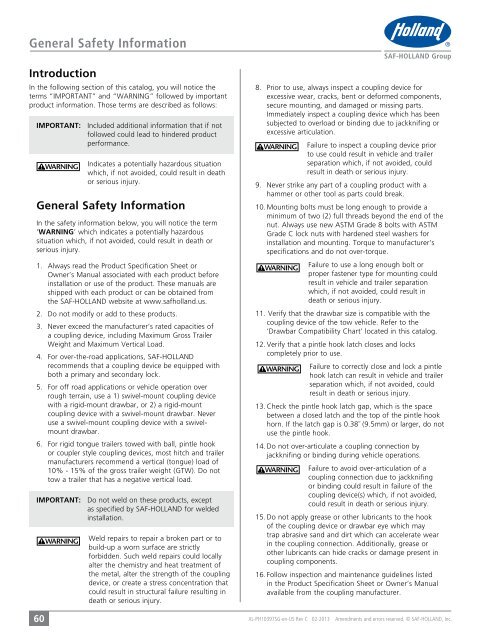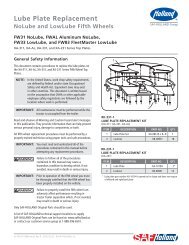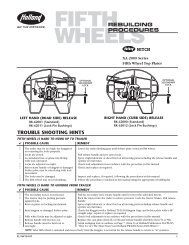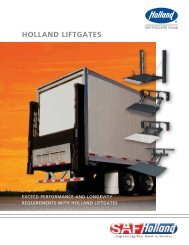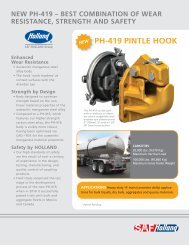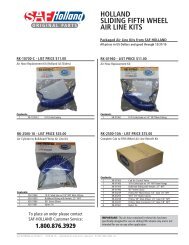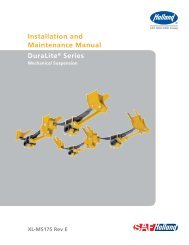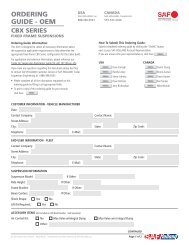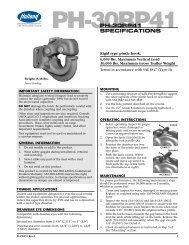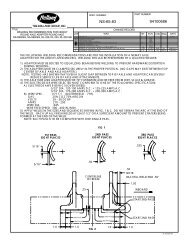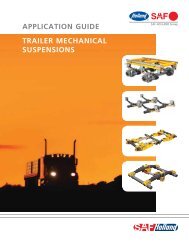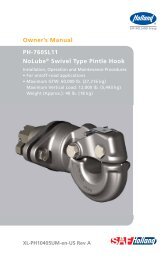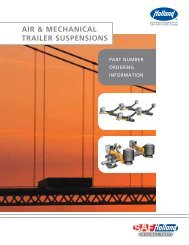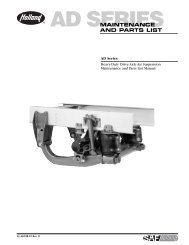XL-PH10397SG - saf-holland
XL-PH10397SG - saf-holland
XL-PH10397SG - saf-holland
You also want an ePaper? Increase the reach of your titles
YUMPU automatically turns print PDFs into web optimized ePapers that Google loves.
General Safety Information<br />
Introduction<br />
In the following section of this catalog, you will notice the<br />
terms “IMPORTANT” and “WARNING” followed by important<br />
product information. Those terms are described as follows:<br />
IMPORTANT: Included additional information that if not<br />
followed could lead to hindered product<br />
performance.<br />
Indicates a potentially hazardous situation<br />
which, if not avoided, could result in death<br />
or serious injury.<br />
General Safety Information<br />
In the <strong>saf</strong>ety information below, you will notice the term<br />
‘WARNING’ which indicates a potentially hazardous<br />
situation which, if not avoided, could result in death or<br />
serious injury.<br />
1. Always read the Product Specification Sheet or<br />
Owner’s Manual associated with each product before<br />
installation or use of the product. These manuals are<br />
shipped with each product or can be obtained from<br />
the SAF-HOLLAND website at www.<strong>saf</strong><strong>holland</strong>.us.<br />
2. Do not modify or add to these products.<br />
3. Never exceed the manufacturer’s rated capacities of<br />
a coupling device, including Maximum Gross Trailer<br />
Weight and Maximum Vertical Load.<br />
4. For over-the-road applications, SAF-HOLLAND<br />
recommends that a coupling device be equipped with<br />
both a primary and secondary lock.<br />
5. For off road applications or vehicle operation over<br />
rough terrain, use a 1) swivel-mount coupling device<br />
with a rigid-mount drawbar, or 2) a rigid-mount<br />
coupling device with a swivel-mount drawbar. Never<br />
use a swivel-mount coupling device with a swivelmount<br />
drawbar.<br />
6. For rigid tongue trailers towed with ball, pintle hook<br />
or coupler style coupling devices, most hitch and trailer<br />
manufacturers recommend a vertical (tongue) load of<br />
10% - 15% of the gross trailer weight (GTW). Do not<br />
tow a trailer that has a negative vertical load.<br />
IMPORTANT: Do not weld on these products, except<br />
as specified by SAF-HOLLAND for welded<br />
installation.<br />
Weld repairs to repair a broken part or to<br />
build-up a worn surface are strictly<br />
forbidden. Such weld repairs could locally<br />
alter the chemistry and heat treatment of<br />
the metal, alter the strength of the coupling<br />
device, or create a stress concentration that<br />
could result in structural failure resulting in<br />
death or serious injury.<br />
8. Prior to use, always inspect a coupling device for<br />
excessive wear, cracks, bent or deformed components,<br />
secure mounting, and damaged or missing parts.<br />
Immediately inspect a coupling device which has been<br />
subjected to overload or binding due to jackknifing or<br />
excessive articulation.<br />
Failure to inspect a coupling device prior<br />
to use could result in vehicle and trailer<br />
separation which, if not avoided, could<br />
result in death or serious injury.<br />
9. Never strike any part of a coupling product with a<br />
hammer or other tool as parts could break.<br />
10. Mounting bolts must be long enough to provide a<br />
minimum of two (2) full threads beyond the end of the<br />
nut. Always use new ASTM Grade 8 bolts with ASTM<br />
Grade C lock nuts with hardened steel washers for<br />
installation and mounting. Torque to manufacturer’s<br />
specifications and do not over-torque.<br />
Failure to use a long enough bolt or<br />
proper fastener type for mounting could<br />
result in vehicle and trailer separation<br />
which, if not avoided, could result in<br />
death or serious injury.<br />
11. Verify that the drawbar size is compatible with the<br />
coupling device of the tow vehicle. Refer to the<br />
‘Drawbar Compatibility Chart’ located in this catalog.<br />
12. Verify that a pintle hook latch closes and locks<br />
completely prior to use.<br />
Failure to correctly close and lock a pintle<br />
hook latch can result in vehicle and trailer<br />
separation which, if not avoided, could<br />
result in death or serious injury.<br />
13. Check the pintle hook latch gap, which is the space<br />
between a closed latch and the top of the pintle hook<br />
horn. If the latch gap is 0.38˝ (9.5mm) or larger, do not<br />
use the pintle hook.<br />
14. Do not over-articulate a coupling connection by<br />
jackknifing or binding during vehicle operations.<br />
Failure to avoid over-articulation of a<br />
coupling connection due to jackknifing<br />
or binding could result in failure of the<br />
coupling device(s) which, if not avoided,<br />
could result in death or serious injury.<br />
15. Do not apply grease or other lubricants to the hook<br />
of the coupling device or drawbar eye which may<br />
trap abrasive sand and dirt which can accelerate wear<br />
in the coupling connection. Additionally, grease or<br />
other lubricants can hide cracks or damage present in<br />
coupling components.<br />
16. Follow inspection and maintenance guidelines listed<br />
in the Product Specification Sheet or Owner’s Manual<br />
available from the coupling manufacturer.<br />
60<br />
<strong>XL</strong>-<strong>PH10397SG</strong>-en-US Rev C 02-2013<br />
Amendments and errors reserved. © SAF-HOLLAND, Inc.


